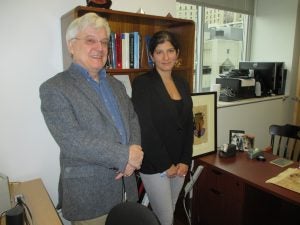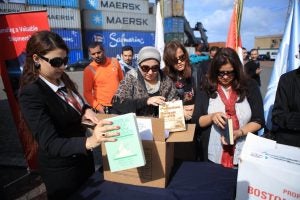
Subscribe to Pittwire Today
Get the most interesting and important stories from the University of Pittsburgh.Sharing the Wealth
How epidemiology emeritus professor Ronald E. Laporte ended up gathering and shipping 6,700 statistics books last month to Alexandria, Egypt, to start a research methods library is a story he characterizes as both “back door” and “crazy.”
Fritz Scheuren, recent head of the American Statistical Association who hopes to help Laporte ship thousands more books to the nascent library this year, is a bit more effusive in his assessment of Laporte’s effort. Scheuren calls him “a mensch … a modern hero whose persistence inspires others, including me. A scholar-saint.”
The story begins in the 1980s, as Laporte recalls, sitting in his office at the Graduate School of Public Health with his long-time partner in the effort, Faina Linkov, an epidemiology and obstetrics, gynecology and reproductive sciences faculty member.
When the Internet arrived, Laporte was working on a global health project for diabetes prevention, and began using the web as a tool to gather PowerPoint lectures from scientists around the world to supplement physical reference libraries in developing countries. There, reference books too often were out of date, Laporte had found. He hoped these PowerPoints could be the basis for new lectures delivered by faculty who did not have such resources in their own universities.
He noted: “How can you teach if you don’t have good materials?”
Plus, these materials would help scholars in developing countries who are under-represented in scientific journals and therefore stymied in their career advancement.
The result of this collection effort was the SuperCourse Project, which still collects presentations on many areas of science, including Laporte’s focal area of global health, and is coordinated by the WHO (World Health Organization) Collaborating Center here at Pitt. Today it includes 199,982 lectures in 33 languages.
The aim is not only to provide teaching materials for faculty around the world, but to connect these instructors and encourage them to conduct and publish research. Among the lectures most viewed over the last six years are presentations on worldwide chemical weapons, healthful farming, the agricultural industry and chemistry.
“The scientists in general have been very, very open in sharing their materials with the world,” said Laporte, and that includes Nobel laureates.
Once the SuperCourse project got underway, Laporte visited Alexandria, Egypt, in 2000 to lecture there and toured the Library of Alexandria, which was just about to open.
Or rather, re-open. Until it was destroyed several decades before the Christian era, the library had flourished for 300 years as the most famous repository of wisdom in the ancient world.
Today it once again houses a large collection of books, with two dozen specialty libraries, museums, academic research centers and other modern facilities. Laporte soon was able to interest founding library director Ismail Serageldin in mirroring the SuperCourse on his organization’s site. Today Serageldin chairs the SuperCourse effort, which has a network specifically geared to African scientists as well.
“He provided an inroad to Arab countries that no one would have gotten in America,” Laporte said of Serageldin. The library thus helps get course materials in front of more eyes in the area surrounding Alexandria, Laporte believes.
By the time they connected with the library, Laporte and Linkov realized that PowerPoints were not the only way to distribute scientific teaching materials to developing countries. They began soliciting YouTube videos for the SuperCourse from their large network of scientists.
Linkov also helped establish the Central Asian Journal of Global Health, published by Pitt as a peer-reviewed journal to directly create more publication opportunities among scientists in this developing region.
Laporte and Linkov then decided to expand their approach to addressing the paucity of scientific instructional materials in the region surrounding the Library of Alexandria.
Although the ancient library site was the repository of the world’s scientific knowledge in its time, Laporte noted, “The new library is not very strong scientifically. But if you look at all the sciences, what’s at the center of science? Research methods.”
So Laporte helped institute a virtual help desk to answer research methodology questions, which became an offering of the Alexandria facility.
“But the problem is, nobody asked any questions,” he said. “It was very disappointing.”
Perhaps they didn’t know where to start asking.
Among those Laporte contacted to contribute a YouTube video of a lecture was Mary Shann, a Boston University professor.
She was about to retire, but suggested contributing 2,000 books on statistics she had accumulated during her career. Laporte said he would see whether the Library of Alexandria would accept such donations.
“That conversation a year ago was the germ of the idea” to add books to the virtual library, Shann said. “You know how incredibly expensive textbooks can be, depending on the field. My books are in pristine condition. I’d hate to see them go to a landfill. They still have a useful life.”
Her donation was the single largest contribution to the library.
Despite all of the information available via the Internet, having access to a book still is an advantage for learning a subject, Shann believes.
“If I were learning this stuff for the first time, I would welcome a YouTube video, but I would really like to have a good, reputable text in my lap or on the desk beside me to aid in my studies.
“Ron has done most of the statesmanship, the communication, reaching out to get people interested and excited about it,” she added. Shann hopes to continue to be involved in expanding library offerings.
The pair of Pitt professors agreed that, while it might not be possible to get the latest books on rapidly changing scientific fields into the Alexandria library in a timely manner, books about the basics of scientific research methods, particularly information on statistical methods, did not go out of date as rapidly.
Laporte said the classic book by R. A. Fisher –— the 1925 “Statistical Methods for Research Workers” — still can be used for teaching. “Statistics isn’t rocket science, and it’s not genetics, which is changing from day to day.”
When working with potential authors for the Central Asian journal, reported Linkov, “One hundred percent of the materials we reject, we reject because of research methods” issues. Even authors whose papers are accepted need some editorial help concerning proper research methods.
“If there is a collection of physical books, there is a lot of symbolism in such an effort,” she said. “It becomes a place where science and its network come together.”
The pair began soliciting more donors, eventually accumulating 6,700 volumes from 150 donors at about 30 universities, stored in a rented warehouse in New York City. Filling a cargo container, the donations finally arrived in Alexandria last month.
Lewis Kuller, faculty member and former chair of the Department of Epidemiology, is one of five Pitt book donors, offering many volumes from his own collection.
“It’s very important,” he said of the library effort. “One of the real goals of the library is to increase both the quality and the quantity of scientific investigations and public health [knowledge] in Africa,” from where there has been a brain drain to the United States, he noted.
“Whether anybody comes there and whether this use has any effect on the health of the population” will be the proof of the value of the project, he added. “I have high hopes that these books will be used. Hopefully they won’t sit there and get dusty in Alexandria as they did in my office.”
Scheuren, of the American Statistical Association, rounded up a pallet of books to include in the shipment and aims to have thousands more books sent in 2017. The statistics association has given Laporte and Linkov $18,000 to continue their efforts this year.
“I want to make this happen — this is a very, very important idea,” Scheuren said — not just for its own sake, but for the cooperation it could foster among local scientists in disparate cultures.
The Library of Alexandria is busy cataloguing the books and plans to make those without copyright issues available electronically.
Laporte believes this is the first, or at least the largest, research methods library in the world. He and Linkov still are busy networking among local Middle Eastern and African countries, trying also to make the collection known to journalists, historians and philosophers who might need to learn statistics for their professions.
Said Linkov: “We feel that every student in the world should know a little bit about statistics.”



